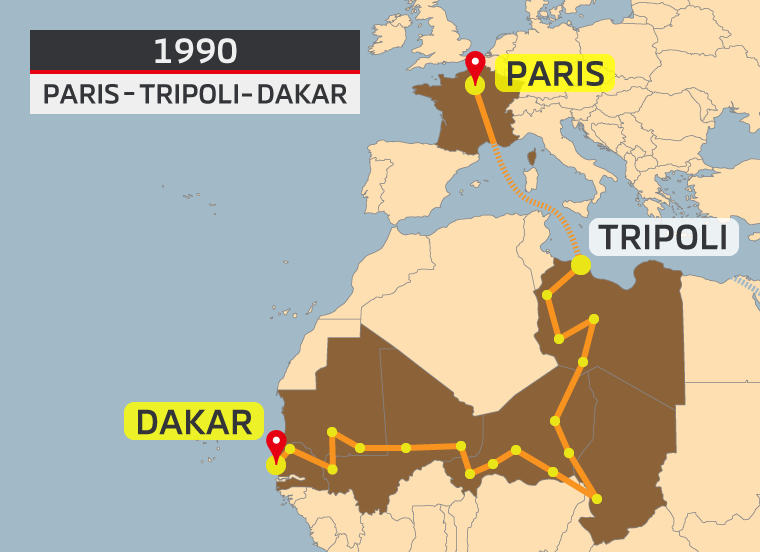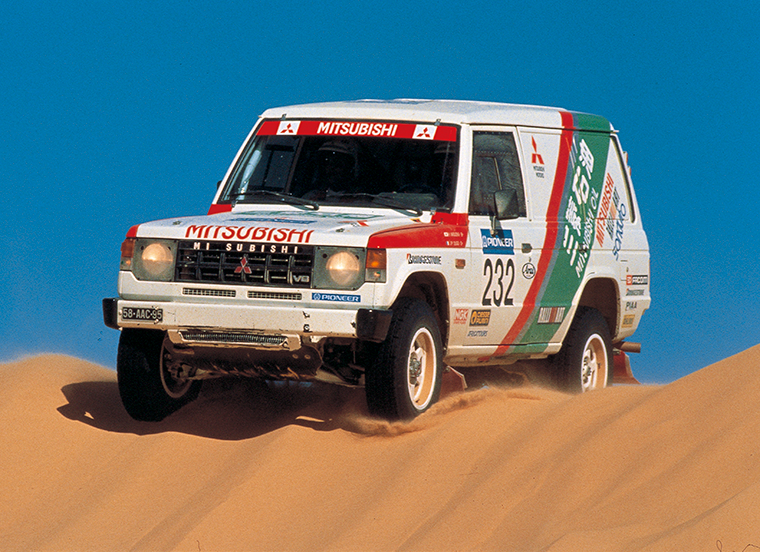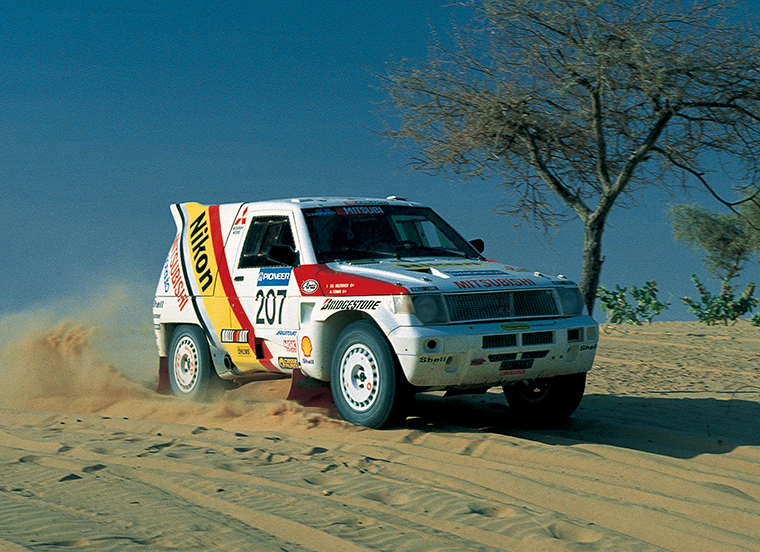
In February 1989, after the conclusion of the 11th Dakar, the Okazaki Motor Sports Team, completed the first research vehicle, the “Okazaki Proto”. The new prototype was designed with a four-wheel double wishbone independent suspension system on a chassis with a multi-tubular frame structure, in which the front and rear A arms are symmetric. The compact 2.2L 4G63 gasoline engine, whose overall length was shorter than that of the 4G54 gasoline engine, had a maximum power of 280PS with a front midship layout. Various ideas were incorporated such as moving the front differential to the center of the car body by offsetting the engine to the right, and extending the driveshaft to reduce the folding angle of the link. The reason why the engine was naturally aspirated was that there was a rumor of a coming change in the regulations prohibiting the turbocharged engines. The prototype based on the Okazaki Proto No.1 car was tested through actual competition, but it was considered that it was too early to enter it in the Dakar Rally. A so-called hybrid version, based on the 1989 model, with rear wheel independent suspension, became the 1990 year model. Cowan, Lartigue, Shinozuka and Fontenay participated in the 1990 model PAJERO/MONTERO Prototypes within the MITSUBISHI MOTORS team. Cowan's 1990 model was powered by a 2.2L 4G63 gasoline turbo engine, which was scheduled to be launched during the next fiscal year. It was based on the Galant VR-4 engine, which at the time competed in the World Rally Championship. The VR-4 had a maximum power of 300PS and a maximum torque of 45 kg-m. In addition, Hiroshi Masuoka was entered in a long wheelbase PAJERO/MONTERO with a 3L V6 gasoline engine in the modified production car class.


On December 25, the 12th event kicked off from the Arc de Triomphe in Paris. The participants landed in North Africa, making their way to Tripoli, the capital of Libya. After a rest day in Agadez on January 7, they headed to Lac Rose, outside the city of Dakar, where the rally finished on January 16. The event had a total distance of 11,391 km, including 7,864 km of competitive stages (SS). That year, the first marathon stage was organized with no service allowed at the bivouac. The marathon stage aimed at correcting the disparity between the factory teams, which have a strong service structure, and the private teams, which have limited service capabilities. However, the major efforts deployed by the works team before and after the marathon stage greatly influenced the situation. As a result, conditions became more severe for the privately-run teams and the completion rate of four-wheeled vehicles was less than 30%.
From the first full-on special stage after arriving in Africa, Peugeot's Vatanen took the lead straightaway. Chasing closely after him, the MITSUBISHI MOTORS team lost the cars of Lartigue and Fontenay in the first half of the race, but Cowan and Shinozuka finished fourth and fifth overall. Although Shinozuka gave a good fight, recording two fastest SS times, the competitiveness of the PAJERO/MONTERO was limited by the fact that it was a prototype based on a production vehicle, while the Peugeot was a prototype based on a rally car designed to Group B WRC specifications. In the meantime, Masuoka finished 10th overall and won first place in the modified production car class, with Yoshimasa Sugawara taking the second place in the class. The Marreau siblings took third place with the PAJERO/MONTEROs sweeping the first four places in the category. Former Motorcycle World Championship winner Takazumi Katayama, who was the first to participate in a MITSUBISHI PX-33 replica, ranked 25th overall.

 In February 1989, after the conclusion of the 11th Dakar, the Okazaki Motor Sports Team, completed the first research vehicle, the “Okazaki Proto”. The new prototype was designed with a four-wheel double wishbone independent suspension system on a chassis with a multi-tubular frame structure, in which the front and rear A arms are symmetric. The compact 2.2L 4G63 gasoline engine, whose overall length was shorter than that of the 4G54 gasoline engine, had a maximum power of 280PS with a front midship layout. Various ideas were incorporated such as moving the front differential to the center of the car body by offsetting the engine to the right, and extending the driveshaft to reduce the folding angle of the link. The reason why the engine was naturally aspirated was that there was a rumor of a coming change in the regulations prohibiting the turbocharged engines. The prototype based on the Okazaki Proto No.1 car was tested through actual competition, but it was considered that it was too early to enter it in the Dakar Rally. A so-called hybrid version, based on the 1989 model, with rear wheel independent suspension, became the 1990 year model. Cowan, Lartigue, Shinozuka and Fontenay participated in the 1990 model PAJERO/MONTERO Prototypes within the MITSUBISHI MOTORS team. Cowan's 1990 model was powered by a 2.2L 4G63 gasoline turbo engine, which was scheduled to be launched during the next fiscal year. It was based on the Galant VR-4 engine, which at the time competed in the World Rally Championship. The VR-4 had a maximum power of 300PS and a maximum torque of 45 kg-m. In addition, Hiroshi Masuoka was entered in a long wheelbase PAJERO/MONTERO with a 3L V6 gasoline engine in the modified production car class.
In February 1989, after the conclusion of the 11th Dakar, the Okazaki Motor Sports Team, completed the first research vehicle, the “Okazaki Proto”. The new prototype was designed with a four-wheel double wishbone independent suspension system on a chassis with a multi-tubular frame structure, in which the front and rear A arms are symmetric. The compact 2.2L 4G63 gasoline engine, whose overall length was shorter than that of the 4G54 gasoline engine, had a maximum power of 280PS with a front midship layout. Various ideas were incorporated such as moving the front differential to the center of the car body by offsetting the engine to the right, and extending the driveshaft to reduce the folding angle of the link. The reason why the engine was naturally aspirated was that there was a rumor of a coming change in the regulations prohibiting the turbocharged engines. The prototype based on the Okazaki Proto No.1 car was tested through actual competition, but it was considered that it was too early to enter it in the Dakar Rally. A so-called hybrid version, based on the 1989 model, with rear wheel independent suspension, became the 1990 year model. Cowan, Lartigue, Shinozuka and Fontenay participated in the 1990 model PAJERO/MONTERO Prototypes within the MITSUBISHI MOTORS team. Cowan's 1990 model was powered by a 2.2L 4G63 gasoline turbo engine, which was scheduled to be launched during the next fiscal year. It was based on the Galant VR-4 engine, which at the time competed in the World Rally Championship. The VR-4 had a maximum power of 300PS and a maximum torque of 45 kg-m. In addition, Hiroshi Masuoka was entered in a long wheelbase PAJERO/MONTERO with a 3L V6 gasoline engine in the modified production car class.

 On December 25, the 12th event kicked off from the Arc de Triomphe in Paris. The participants landed in North Africa, making their way to Tripoli, the capital of Libya. After a rest day in Agadez on January 7, they headed to Lac Rose, outside the city of Dakar, where the rally finished on January 16. The event had a total distance of 11,391 km, including 7,864 km of competitive stages (SS). That year, the first marathon stage was organized with no service allowed at the bivouac. The marathon stage aimed at correcting the disparity between the factory teams, which have a strong service structure, and the private teams, which have limited service capabilities. However, the major efforts deployed by the works team before and after the marathon stage greatly influenced the situation. As a result, conditions became more severe for the privately-run teams and the completion rate of four-wheeled vehicles was less than 30%.
On December 25, the 12th event kicked off from the Arc de Triomphe in Paris. The participants landed in North Africa, making their way to Tripoli, the capital of Libya. After a rest day in Agadez on January 7, they headed to Lac Rose, outside the city of Dakar, where the rally finished on January 16. The event had a total distance of 11,391 km, including 7,864 km of competitive stages (SS). That year, the first marathon stage was organized with no service allowed at the bivouac. The marathon stage aimed at correcting the disparity between the factory teams, which have a strong service structure, and the private teams, which have limited service capabilities. However, the major efforts deployed by the works team before and after the marathon stage greatly influenced the situation. As a result, conditions became more severe for the privately-run teams and the completion rate of four-wheeled vehicles was less than 30%.
